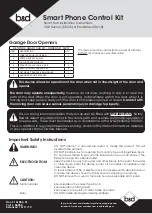
a
b
A
B
a
90°
ENGLISH
8
6 POSITIVE STOP -
(INTERNAL MECHANICAL TRAVEL-LIMIT STOPS)
The S700H operator is supplied standard with internal opening
and closing mechanical stops. This is to facilitate the installation
operations because there is no need to construct the mechanical
stop elements.
The mechanical travel-limit stops (POSITIVE STOP) can be adjusted
in the last 30° of the operator’s MAXIMUM travel, at both opening
and closing.
FAAC SUPPLIES THE TRAVEL LIMIT DEVICES TOTALLY OPEN ( MAXIMUM
PINION ROTATION ANGLE ) ,
6.1 ADJUSTMENT OF THE TRAVEL-LIMIT STOPS
TRAVEL-LIMIT STOP
AT OPENING
TRAVEL-LIMIT STOP AT CLOSING
Fig.20
1) Hydraulically release the operator. (See chpt 8.1)
2) Close the leaf, manually taking it into its closed position.
3) Unscrew the cap (Fig. 20 ref.A) of the closing travel-limit screw
(Fig. 20 ref.
a
)
CLOSING POSITION
OPENING POSITION
Fig.19
1) Take the gate to its open position.
2) Consulting the instructions in chapter 8.1, hydraulically release
the operator, using the key (Fig. 1 ref.
r
) on the release screw
(Fig. 1 ref.
f
)
3) On the operator, unscrew the cap (Fig. 16 ref.A) of the closing
travel-limit screw (Fig. 16 ref.
a
).
4)
Unscrew the closing travel-limit
(Fig. 16 ref.A)
screw by
one turn (IMPORTANT FOR CORRECT COUPLING OF THE
PINION-MECHANICAL RELEASE DURING INSTALLATION).
5) Turn the operator pinion with the supplied key (Fig. 1 ref.
r
),
in
the gate closing direction
as shown in Fig. 16, up to the internal
stop point of the piston, and remove the key.
6)
Without moving the pinion
, insert the supplied key on the
operator as shown in Fig. 17, and make sure that it indicates 0
(ZERO) on the operator’s plastic panel (Fig. 17 ref.
a
). If necessary
rotate the pinion with this.
( I M P O R T A N T F O R C O R R E C T C O U P L I N G O F T H E
PINION-MECHANICAL RELEASE DURING INSTALLATION)
.
NOTE: if necessary, lightly screw the closing travel-limit screw
7) Remove the adjustment key
8) Lightly grease the operator pinion.
9) Using the handles, insert the operator in the bearing case as
shown in Fig. 18 A
10) Take the gate to its
CLOSED position
.
11) Free the mechanical release, referring to paragraph 8.2.
12) Take the released gate into open position, making sure that
the released part freed from the gate
remains in the gate closed
position as shown in Fig. 9 ref.
a
.
13) Raise the operator with its handles (Fig. 18 ref. B), inserting the
pinion in the grooved bush in the bearing case. If it does not enter,
slightly rotate the operator until coupling takes place.
14) Insert and screw the fastening screws with groover and washer
as shown in Fig. 18 B ref.
a
, in order to secure the operator to the
bearing case (TO FACILITATE THE OPERATION, SUPPORT THE MOTOR
FROM BENEATH THE CENTRAL PART).
15) Close the gate and re-lock it to the mechanical release.
16) Open and close the gate, checking and, if necessary,
adjusting the respective travel limit devices as described in
chapter 6.1.
17) As described in the instructions for the control unit, make the
electrical connections, taking care over encoder polarity.
18) Hydraulically shut down the operator as per instructions in
chapter 8.1.
5.4.2 OPERATOR WITH MECHANICAL RELEASE




























